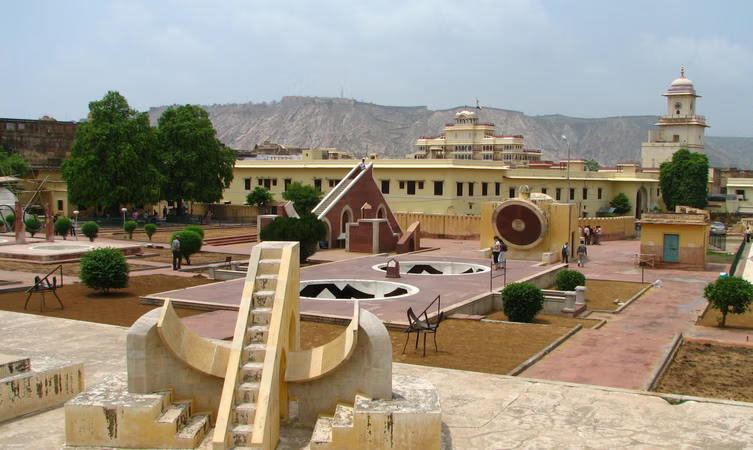The Jantar Mantar Observatory in Jaipur, India, stands as a monumental testament to the astronomical and architectural brilliance of 18th-century India. Built by the Rajput king Sawai Jai Singh II, the founder of Jaipur city, this remarkable site was completed in 1734. It is the most significant, comprehensive, and best-preserved of India’s historic observatories, earning it a UNESCO World Heritage Site designation in 2010.
Historical Context and Visionary Patronage:
Maharaja Sawai Jai Singh II was not merely a ruler; he was a profound scholar with a fervent interest in astronomy, mathematics, and urban planning. Recognizing the limitations of existing astronomical tables and instruments, he embarked on a ambitious project to construct five observatories across northern India: in Delhi, Jaipur, Ujjain, Mathura, and Varanasi. Of these, the Jaipur Jantar Mantar is the largest and most elaborate, serving as the culmination of his scientific endeavors.
The name “Jantar Mantar” is derived from Sanskrit, with “Jantar” (from yantra) meaning instrument or machine, and “Mantar” (from mantrana) meaning to consult or calculate. Thus, it literally translates to “instrument used for calculation.” Jai Singh’s primary aim was to refine ancient Islamic astronomical tables (known as Zij), measure the exact local time continuously, and precisely define the calendar. The observatory was also a strategic symbol of royal authority, linking scientific prowess with urban design and social control.
Unique Instruments and Architectural Innovations:
The Jantar Mantar in Jaipur comprises a collection of nineteen main fixed instruments, predominantly constructed from local stone and marble, though some incorporate bronze tablets, bricks, and mortar. These instruments are monumental in scale, designed for naked-eye observation of celestial bodies, achieving remarkable precision through their sheer size.
Some of the most notable instruments include:
- Samrat Yantra (The Supreme Instrument): This colossal equinoctial sundial is arguably the most famous instrument and the world’s largest stone sundial. Its gnomon arm stands 22.6 meters high, with two lateral quadrants of 15.15 meters radius. It is capable of measuring local time with an astonishing accuracy of two seconds. The sheer scale allows for a palpable experience of Earth’s cosmic motion as the gnomon’s shadow moves.
- Jai Prakash Yantra: This highly innovative sundial consists of two hemispherical bowls that create an inverse image of the sky. Observers could move freely inside to take readings, allowing for the determination of celestial object coordinates in both azimuthal-altitude and equatorial systems.
- Rama Yantra: A double-cylinder instrument used to record the azimuth and altitude of celestial bodies.
- Rasivalaya Yantras: A set of twelve gnomon dials, each corresponding to a zodiacal constellation, used to measure the ecliptic coordinates of stars and planets when they crossed the meridian.
- Digamsa Yantra: Used to determine the azimuth of the sun and predict sunrise and sunset times.
- Narivalaya Yantra: Employed to determine the sun’s hemispheric location.
- Shastansh Yantra: Built within towers, it utilizes a pinhole camera mechanism to measure specific solar parameters like zenith distance, declination, and diameter.
- Yantra Raj Yantra: An adaptation of an astrolabe, this massive bronze instrument (2.43 meters in diameter) is one of the largest in the world and was used to calculate the Hindu calendar.
Significance and Legacy:
The Jantar Mantar represents a unique convergence of scientific, religious, and political needs. It embodies the Ptolemaic positional astronomy tradition, a system of observing the universe shared by numerous civilizations across Western, Middle Eastern, Asian, and African cultures for over fifteen centuries. Jai Singh’s observatories were a meeting point for different scientific cultures, fostering widespread social practices linked to cosmology and demonstrating the intellectual achievements of the Rajput era.
While the observatory was actively used during Jai Singh II’s lifetime, its use declined after his death in 1743 due to political turmoil. However, it underwent several significant restorations, notably in the late 19th century and again in 2006, ensuring its preservation. Today, the Jantar Mantar in Jaipur is not only a historical landmark but also an open-air museum that continues to awe visitors with its scale, precision, and the ingenuity of its ancient engineering. It stands as a powerful reminder of India’s rich scientific heritage and its profound contributions to the understanding of the cosmos.
